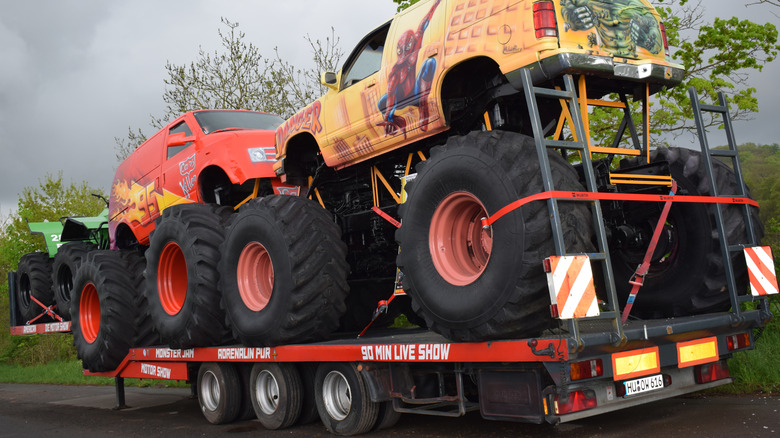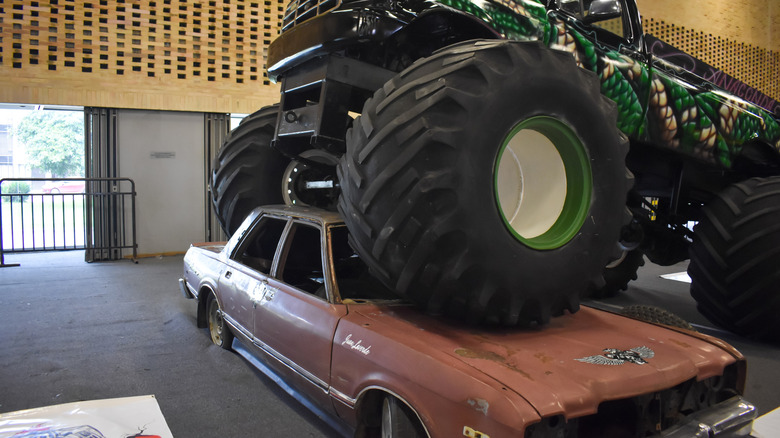How Big Are Most Monster Trucks Tires & How Much Can They Cost?
With their striking and colorful designs, ranging from animal-themed to dinosaurs and real-life vehicles, monster trucks are some of the most astounding vehicles ever made. Capable of performing creative vehicular stunt work, including wheelies, back flips, donuts, and jumping considerable distances using a ramp, monster trucks are used for automotive-themed shows and exhibitions that perform for crowds all across the United States and abroad. Specially built with a highly durable chassis, powerful engines, and equipped with its most recognizable feature — the massive tires. These mountains of rubber are 66 inches tall, 43 inches wide, and can cost between $2,000 and over $4,000 each.
According to Balkrishna Industries Limited (BKT Tires), the company that manufactures and supplies tires for some of the most legendary monster trucks and for industrial and agricultural equipment, the tires are made from a unique combination of chemical compounds that are built to withstand increased temperatures, and resist the stress and impact of use. Because of its size, the tire is quite heavy at 645 pounds and is filled with 23 psi of air pressure, and features a tread design that maximizes grip, and rounded shoulders for better balance.
At nearly 11 feet tall, 17 feet long, and more than 12 feet wide, monster trucks are massive vehicles weighing the equivalent of five 2022 Chevrolet Sparks, or 12,000 pounds. Monster trucks require very large tires to manage the load distribution and provide enough ground clearance to traverse obstacles. Lastly, the big tires provide protection and cushioning from the impact of the stunts it performs and prevent the truck from getting stuck in mud. Interestingly, despite its size, monster truck tires pale when compared to what pit mining trucks use, as those are the biggest tires in the world.
Big wheels for needed for big stunts
The origins of the monster truck can be traced to the 1970s when off-roading enthusiast Bob Chandler began modifying his personal and business-use Ford F-250 truck. The truck was gradually modified throughout the years, starting with fitting bigger and bigger tires, and also received a series of stronger engines, similar to what powers modern monster trucks, to cope with the added weight. As the truck became bigger and more powerful, it became an attraction at various car shows, where it was named Bigfoot after its owner. In 1981, the truck was featured in a movie called "Take This Job and Shove It," and gained national fame where the press named it a monster truck, a moniker that remains to this day.
The earliest monster trucks used a variety of tires, including those made for military specialty vehicles, agricultural equipment, and swamp use trucks. The early tires, however, were heavy, weighing 800 pounds, which affected the speed and handling of the truck, and had to be altered by using lathes to cut out sections of the tread that resulted in weight savings of nearly 50%. The first purpose-built monster truck tires only became available 30 years later, when the SiR racing team released its lightweight tire.
Because of the events the truck participates in, such as competitions or exhibitions, its tires are subjected to intense stresses like which cause deformation. This is why its tire life can range from just 24 weeks or more, which is one season, to substantially less, as the tires can be ripped or substantially damaged and cannot be reused again. From its makeshift origins to today's bespoke, technical equipment, monster truck tires, like the trucks it is used for, have evolved to become better and safer.

